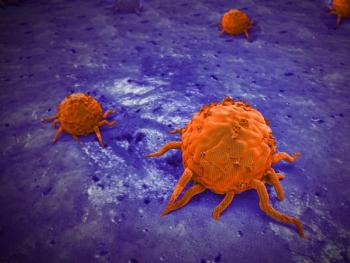
Oncology NEWS International
- Oncology NEWS International Vol 8 No 9
- Volume 8
- Issue 9
Modified SPECT Scintimammography Proves More Accurate
NEW ORLEANS-A modification of SPECT (single proton emission computed tomography) scintimammog-raphy with the radionuclide technetium sestamibi is a promising adjunct to equivocal mammograms that are difficult to interpret, said David H. Feiglin, MD, professor of radiology, SUNY Health Science Center, Syracuse. He presented the findings of his collaborative study at the American Roentgen Ray Society annual meeting.
NEW ORLEANSA modification of SPECT (single proton emission computed tomography) scintimammog-raphy with the radionuclide technetium sestamibi is a promising adjunct to equivocal mammograms that are difficult to interpret, said David H. Feiglin, MD, professor of radiology, SUNY Health Science Center, Syracuse. He presented the findings of his collaborative study at the American Roentgen Ray Society annual meeting.
Currently, the procedure for SPECT reconstruction of sestamibi distribution in breast tissue utilizes standard filtered back-projection (FBP) algorithms. Streak artifacts with no resolved uptake in breast tissue occur due to confounding high activity in heart and liver.
New Algorithm
Dr. Feiglin and his colleagues have developed a new statistical algorithm to provide clinically useful images of sestamibi in the breast.
First, a breast phantom was created, utilizing a variety of hollow spheres of known diameter placed between saline bags strapped to a standard chest phantom. Their location was spacially confirmed using multiplanar MR imaging.
The levels of radioactivity during SPECT imaging could be varied over a wide range. The breast phantom allowed collection of large data sets for analysis.
The algorithmic function derived from the phantom studies was then applied before SPECT reconstruction, to compress the dynamic range of the data. Standard FBP was subsequently utilized, with the appropriate inverse algorithm applied afterward to decompress the data. Finally, scatter correction was applied.
The newly modified procedure was tested in 18 women with small, palpable breast masses. After x-ray mammography, and before needle biopsy, planar imaging and SPECT (both standard and modified) scintimammography were performed. Planar imaging was done both before and after SPECT imaging. MR imaging was also performed.
Conventional SPECT failed in all 18 cases. With standard SPECT, we saw nothing in the breast, Dr. Feiglin said, but the modified SPECT procedure detected three tumors not found on planar imaging. Overall, the new procedure was superior to planar imaging and similar to MR imaging.
Modified SPECT certainly improves on standard SPECT imaging, Dr. Feiglin said. Even at low levels of activity you can discern activity you cant see with the standard reconstruction.
Articles in this issue
over 26 years ago
‘Gonzalez Diet’ to Be Tested in Pancreatic Cancerover 26 years ago
Talking to Members of Congress About Cancer Issuesover 26 years ago
Lilly Enjoined From Promoting Evista for Breast Cancer Preventionover 26 years ago
Experts Brief Capitol Hill on Trial Costs Surveyover 26 years ago
NIH Plan Quadruples Prostate Cancer Research Fundsover 26 years ago
Gabapentin as Adjuvant to Opioids in Neuropathic Painover 26 years ago
Biochemotherapy May Be an Option in Metastatic Melanomaover 26 years ago
PET Scans Spare Some NSCLC Patients From Mediastinoscopyover 26 years ago
Computer Technique Gives New Life to Thermal Breast Imagingover 26 years ago
Kytril Indicated to Prevent RT-Induced Nausea and VomitingNewsletter
Stay up to date on recent advances in the multidisciplinary approach to cancer.


















































































